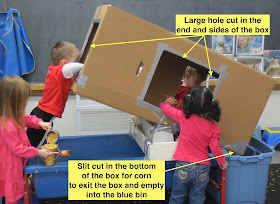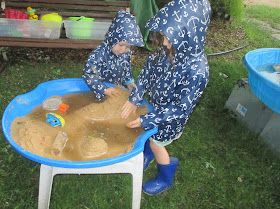In essence, I created an apparatus that more than doubled the working space for children at the sand table. Not only that, I also increased the number of levels they could work on. See #2 under Elements and Orientations and #3 under Axioms on the right hand column of this blog.
With this construction, I also created some unique spaces in which the children could operate. There was the space underneath the horizontal box over the yellow table. There was the space inside the horizontal box.
There was also the space inside the box next to the table. That space was different because it was surrounded by high cardboard walls and accessed through deep openings cut in the sides of the box. That space was also intriguing because the horizontal box encroached into the volume of that box and the encroachment created new spaces underneath and on both sides.
This was an open design in which the children could access the spaces in multiple ways. They could go over the top or work though the holes cut in the side and on the end.
In the picture above, a child even used the corner of the horizontal box to support his container as he worked with the sand.
I have begun to wonder if the apparatus I built for the sensory table---even from the beginning---can be considered a loose part and be informed by Simon Nicholson Theory of Loose Parts. His theory states:
"In any environment, both the degree of inventiveness and creativity, and the
possibility of discovery, are directly proportional to the number and kind of
variables in it."
Can the spaces, levels and holes I created when I built the apparatus be considered variables for the purposes of his theory?
I come about this question from a couple of different angles. The first is in relation to what I usually see as examples of indoor loose part constructions on the internet. Much of what I see has a definite artsy quality to it. I am thinking of pictures I have seen of jewels, sticks, rocks, scarves, mirrors, etc. that are usually arranged symmetrically with an eye for aesthetics. Not only are these beautiful constructions, they also fulfill another important part of Nicholson's theory, namely, that is important for children to construct the environment so it becomes more meaningful to them.
The second angle follows from the first and it always comes up when I do workshops. People ask me if I include the children in the building process. I have never had a good answer for that question other than to say: "No. That is my creative outlet. And doesn't everyone need a creative outlet?"
So not only are my cardboard and duct tape constructions not beautiful, children are not part of the building process. Have I just answered my own question? On the other hand, even though the children do not do the actual building, they do make the apparatus their own through their play and exploration. Is there a place in the theory of loose parts for a static object such as a boxes in boxes apparatus with its affordances as the variables that are only realized through the children's explorations of those affordances?

























